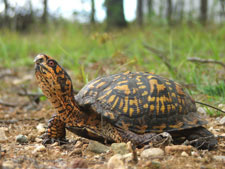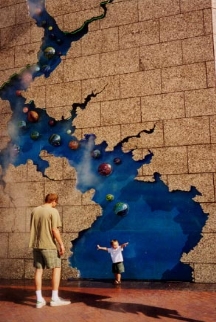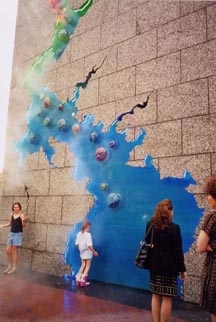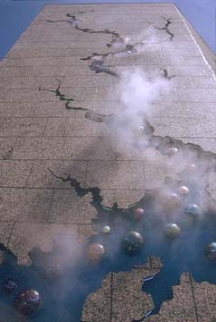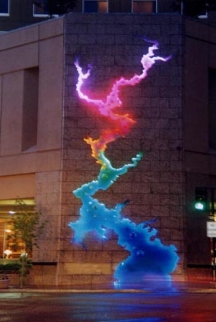|
Blackstone River Watershed Association
|
|
|
BRWA NEWS
|
Blackstone River and Canal Heritage State Park Hike
Ranger Chuck Arning of the National Park Service led twenty bundled
hikers on a fascinating hike back through time and across cultures
on Saturday March 23 to learn about the changes that humans and
nature have produced on the Blackstone Valley landscape.
Over the
course of two hours, the group traveled from the Visitor Center at
River Bend Farm in Uxbridge north along the Blackstone Canal towpath
and through the surrounding woodlands to the Goat Hill lock. We
learned how the Nipmuc, Narragansett and Wampanoag peoples used
controlled burns to clear out the understory of the forest, creating
what early European visitors saw as a park-like setting. We learned
that the rocky hillsides were no good for growing crops but provided
adequate grazing land for goats, hence the name Goat Hill. We heard
how the success of regional textile mills released women from their
all-consuming work of spinning and the introduction of efficient iron
cook-stoves reduced the domestic need for trees already in demand by
shipbuilders.
A view of Goat Hill Lock
looking downstream. This is the only intact lock remaining from the 1828 Blackstone Canal.
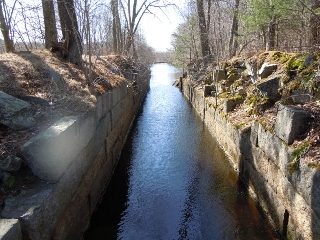
|
We heard the story of how lessons learned from building
the Erie Canal were applied within a few years, along with the
building skills of Irish immigrants, to develop the Blackstone Canal,
which was completed in 1828. Ranger Arning showed us examples
alongside the hiking trail of granite blocks cut for the canal locks
by experienced stoneworkers and those cut by in-experienced workers.
He explained that the working towpath, unlike today’s remnants, had
to be maintained free of rocks, roots and vegetation that could impair
passage of horses towing the barges. We observed how side channels were
cut from the river to supply water to the canal. And we observed how
the Goat Hill lock has survived intact with little deterioration until
relatively recently, when an increased frequency and intensity of storms,
indicative of climate change, has caused a measurable shift in the
granite blocks.
Ranger Chuck Arning talks
about the ways people have changed the Blackstone River.
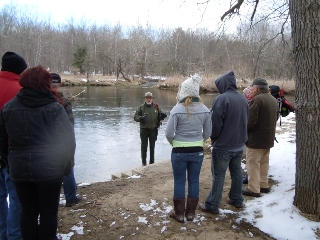
|
Retracing our steps back to the visitor center, we
enjoyed hot cider and cookies and agreed that Ranger Arning had indeed
taken us all on a marvelous journey. The next time you find yourself
in Uxbridge, come visit River Bend Farm and embark on your own journey
back in time!
top
|
 Earthday Cleanup & Clean and Green Fair
Earthday Cleanup & Clean and Green Fair
In celebration of Earth Day, the BRWA is
sponsoring its annual river cleanup on Sunday, April 21, from
1:00 – 3:00p.m. in conjunction with the Mass Department of
Conservation and Recreation (DCR) Park Serve Day being held throughout
the state.
 Team Leaders will work with volunteers at sites in Grafton,
Millbury, Northbridge, Uxbridge, and Blackstone. Please let us know
if you are aware of a site that needs cleaning in these or other towns.
This project meets community service requirements for many organizations.
Every year we have over 100 volunteers including students, scouts,
church groups, business leaders, sport clubs and more. At 3:00p.m,
free pizza and drinks will be provided to cleanup volunteers at the
River Bend Farm Visitor Center, Oak Street, Uxbridge.
Team Leaders will work with volunteers at sites in Grafton,
Millbury, Northbridge, Uxbridge, and Blackstone. Please let us know
if you are aware of a site that needs cleaning in these or other towns.
This project meets community service requirements for many organizations.
Every year we have over 100 volunteers including students, scouts,
church groups, business leaders, sport clubs and more. At 3:00p.m,
free pizza and drinks will be provided to cleanup volunteers at the
River Bend Farm Visitor Center, Oak Street, Uxbridge.
In addition, the BRWA and Alternatives Unlimited, Inc. will be
sponsoring a Clean and Green Fair from 2:30-4:00p.m. at the Visitor
Center. You can plant and take home a seedling, watch demonstrations
on terracycling and on stormwater-recycling with downspouts and rain
gardens, participate in an interactive watershed model, and enjoy
children’s activities!
Events will be held rain or shine. For more information, to suggest
a cleanup site, or to volunteer for the cleanup, contact: Susan Thomas,
BRWA Project Coordinator at 508-278-5200 or at
events@thebrwa.org.
top
|
Got Website?
Have you visited the BRWA’s new and improved
website? We went “live” with it just a few months ago and are
excited about sharing it with everyone living or working within the
Blackstone River watershed. It has something for everyone!
Are you
a paddler? You can find out how we’ve improved access for boaters.
Are you curious about some plants you’ve seen choking out
a local waterway? You can identify the invasive aquatic plants in
our watershed and participate in our efforts to remove these invasives.
Are you a teacher with students learning about the environment?
You can read about our interactive watershed model program that we
bring into the classroom. Are you a homeowner, small-farm operator,
or developer? You can learn about Best Management Practices that
benefit both you and the environment. Do you need to complete
community service hours? You can find out when and where our next
river cleanup event is being held. Are you concerned with water
quality issues? You can learn about the BRWA’s role in the Blackstone
Water Coalition’s ongoing, watershed-wide, volunteer water quality
monitoring program that runs April through November each year.
Are you an engaged citizen wanting to know what the BRWA has
accomplished through all these initiatives over the years? You can
read our 2012 Report that summarizes our achievements. Are you ready
to volunteer to support the BRWA’s mission to engage, educate, and
advocate to improve water quality in the Blackstone River watershed?
Well you’ve come to the right place. Our
new and improved website will give you both the background and
guidance to find the right fit for you. Thank you for taking a look
and help pass the word!
top
|
|
CALENDAR OF EVENTS
|
April 22 is Earth Day!
But is there any reason why we can’t make everyday
Earth Day with a small thought or act? We all make choices each day that
can either help or hurt the environment. Make an effort this month to be
mindful of these opportunities for good choices.
|
Pledge To The Planet
I pledge allegiance
to the web of life
of which we’re each a strand
and to our planet earth
on which we stand
one ecosystem
under the sun
interdependent
with diversity
and respect
for all.
Reprinted with permission from Jackson Gillman
http://www.jacksongillman.com/index.html
|

|
|
4/20
|
Blackstone River Watershed Council/Friends of the Blackstone Open House.
Friends of the Blackstone Environmental Center at Sycamore Landing
100 New River Road Manville, RI.
For more information, contact Keith Hainly at 401-996-1542
or KeithHainley@BlackstoneRiver.org.
|
|
4/21
|
Annual Earth Day Cleanup and Clean and Green Fair. 1:00p.m-4:00p.m.
River Bend Farm, 271 Oak Street, Uxbridge and sites throughout the
Blackstone River Watershed. See above for details.
Contact Susan Thomas at
susan.thomas@thebrwa.org.
|
|
4/22
|
Earth Day! Celebrate Mother Earth!
|
|
4/23
|
Worcester Rain Gardens to the Rescue Workshop.
7:00 p.m. Knights of Columbus, Worcester, MA. See below for details.
Contact Donna Williams at dwilliamsbrc@aol.com.
|
|
4/25
|
Saving Land and Money through Open Space Design workshop. 4:00PM – 6:00 PM.
Harvard Forest, 324 North Main Street (Route 32), Petersham.
Mass Audubon’s Shaping the Future of Your Community Program.
Pre-registration is requested but not required:
info.
|
|
4/27
|
Annual Statewide Volunteer Day. 9:00a.m. – 12:00p.m. Mass Audubon.
Contact: 781-259-2185 or volunteers@massaudubon.org.
|
|
4/27
|
Prescription Drug Take-Back Day. 10:00a.m. - 2:00p.m.
See below for details.
info
|
|
5/2
|
Worcester Rain Gardens to the Rescue Workshop.
7:00 p.m. Unitarian Universalist Church , Worcester, MA. See below for details.
Contact Donna Williams at dwilliamsbrc@aol.com.
|
|
5/4
|
Annual Massachusetts Trails Conference. 8:00a.m. – 4:00p.m.
Devens Common Center, 31 Andrews Parkway, Devens.
The Massachusetts Recreational Trails Advisory Board (MARTAB).
info
|
|
5/11
|
BCC Workday. 9 a.m. at Plummer’s Landing, Church St.
Northbridge, MA.
Info from Dave Barber 508-478-4918
|
|
5/11
|
Southern New England Discovery Tours. Blackstone
Valley Tourism Council.
info
|
top
|
THINK GLOBAL, ACT LOCAL
|
Worcester Rain Gardens Workshops
The Worcester Stormwater Coalition is sponsoring
five, hands-on workshops for homeowners and business owners to learn how
to protect and restore Worcester’s waterways by reducing polluted runoff
from yards, rooftops, driveways, roads and other impervious surfaces.
The Rain Gardens to the Rescue! workshops will take place at different
locations throughout the City in the Spring. They are co-sponsored by
local environmental groups. Dates and locations for the workshops are as
follows: Tuesday, April
23, at the Knights of Columbus Hall; and Thursday, May 2, at the Unitarian
Universalist Church. All workshops begin at 7:00p.m.
Homeowners and business owners are invited to attend any of the workshops
to learn what they can do on their own property to enhance their
landscaping, reduce polluted runoff, and protect the City’s water
resources no matter where they are located.
At the workshop, participants will learn how to harvest rainfall, reduce
runoff, and save money on water and sewer bills by redirecting roof runoff,
installing rain barrels, and creating rain gardens. Rain gardens are designed
to accept runoff from rooftops, roads and parking lots. They infiltrate
stormwater into the ground and filter out pollution, reducing the volume
of water and pollutants hitting our waterways.
Polluted runoff from stormwater is the leading remaining cause of water
quality problems, because it flows, untreated, directly through storm drains
into the waterbodies we use for swimming, fishing, and drinking water.
Participants can learn about the many practices that reduce these negative
impacts.
The workshops are free and open to the public. They are funded in part by
the Massachusetts Environmental Trust. There will be door prizes and free
homeowner’s guides. For questions and to register, contact Donna Williams
at 508-335-8393 or dwilliamsbrc@aol.com.
Information can also be found at
www.zaptheblackstone.org.
top
|
Invasive Plant Removal
The town of Mendon recently approved the use of
Community Preservation Funds to remove Asian water chestnut from
Inman Pond. Asian water chestnut is an invasive aquatic plant that can quickly
cover and choke out a small waterbody. The plant’s unchecked spread
reduces habitat for native plants and animals, and restricts access
for recreational boaters. This aquatic invasive is particularly
challenging to tackle because its seed balls can lay dormant in a pond’s
sediment for 12 years before germinating.
top
|
Water Contamination from Pet Feces
Health officials in Hopedale have implemented a
public education campaign to put an end to disposal of bagged dog feces
in residential storm drains. Some people may still assume that water
carried into storm drains from roads and parking lots is processed in the
same manner as water entering sewer drains from homes and businesses.
In fact, storm runoff is discharged—untreated, into wetlands and waterways.
This means that any contaminants in the runoff including oils, fertilizers,
household and industrial toxins and chemicals, manure and pet feces also
enter our wetlands and waterways. Dog feces contain bacteria that impair
water quality and can harm plants and wildlife. It also contributes to
fish consumption advisories and beach closings. Dog walkers should dispose
of bagged feces with their other household trash. This simple act will
help clean up the environment that we all share.
top
|
Prescription Drug Take-Back Day
The President’s Cancer Panel’s 2008-2009 Annual
Report focused on reducing environmental risks for cancer. In the report,
the Panel states that "…pharmaceuticals have become a considerable source
of environmental contamination. Drugs of all types enter the water supply
when they are excreted or improperly disposed of; the health impact of
long-term exposure to varying mixtures of these compounds is unknown.”
In an effort to reduce this contamination, the Drug Enforcement
Administration (DEA) has scheduled a National Prescription Drug Take-Back
Day that will take place on Saturday, April 27, 2013, from 10:00 a.m. to
2:00 p.m. This is a great opportunity for those who missed previous events,
or who have subsequently accumulated unwanted, unused prescription drugs,
to safely dispose of those medications. Local drop off places are listed
on the DEA’s website
www.deadiversion.usdoj.gov/drug_disposal/takeback/.
top
|
|
SPOTLIGHT ON SCIENCE
|
Hydric Soils
Soils are the basis of all terrestrial life.
As the interface between living plants above the surface and bedrock below
the surface, soil is where the essential cycling of organic and mineral
nutrients occurs. It also provides habitat for animals and substrate for
plants. Understanding the hierarchy of different soil types helps to put
the ecological foundation of soils into perspective.
Soils can be either hydric or non-hydric. A hydric soil is defined by
the Natural Resource Conservation Service (NRCS) as “a soil that formed
under conditions of saturation, flooding or ponding long enough during
the growing season to develop anaerobic conditions in the upper part.”
Anaerobic means that there is no oxygen present because the air spaces
have been filled with water. Anaerobic conditions preclude any of the
standard, oxygen-supported bacteria that break down organic materials
like dead plants and animals into the essential basic nutrients that
are then recycled back into the system. This also holds true for other
soil-decomposers, like worms, beetles, and non-bacterial microorganisms
that require oxygen.
The lack of oxygen produces what is referred to as a reducing environment,
in which redox chemical reactions are limited. Redox reactions involve the
transfer of electrons between atoms and are how elements change form.
Examples include hydrogen changing into methane, and carbon transforming
into carbon dioxide. The production of these green-house gases is currently
the subject of considerable research and discussion in light of climate
change.
Understanding hydric soils is integral to understanding how any waterway
and its surrounding floodplain functions. Water moves over and through
soil to reach waterways, and the specific characteristics of each soil
type dictates how that movement occurs. It also affects the animal and
plant life supported by those soils. The presence of hydric soils is one
of three factors used in identifying jurisdictional wetlands.
Hydric soils can be categorized as either mineral or organic. Mineral
soils contain very little or no organic material and are comprised of
sand, silt, and clay particles in varying proportions. Texture is one
way to identify the primary component. Clay soils leave an oily smear
when you rub them between your fingers. Sandy soils have a gritty texture
and silty soils have a slippery texture like baby powder. Mineral soils
also vary in their color, ranging from grey, called gleyed, to red. Soil
and wetland scientists use the Munsell Color Guide to identify soil
types by their color. Gleyed soils have been saturated for long periods
of time and the color results from the chemical reduction of iron,
manganese, and other elements. Other soil types show red mottling because
they have not been inundated long enough to producing gleying. Brighter
mottling can indicate that the water table has fluctuated.
Munsell Color Guide
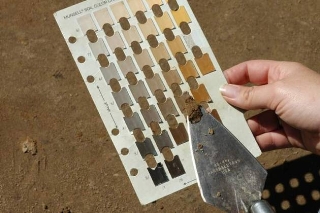
|
In contrast to mineral hydric soils, organic hydric soils, called
histosols, form under conditions of almost continuous saturation. They
contain significant amounts of organic plant material and are typically
referred to as peats and mucks.
In addition to texture and color, hydric
soils types can be differentiated based on their soil profile —layers
that are observed from the ground’s surface down. These layers are called
horizons and have unique color, texture, and structure. Hydric soils
typically have A, B, and C horizons. The A horizon is the surface soil,
also called topsoil. It has organic matter being added to it on a
regular basis, and its organic and mineral material is always traveling
downward into lower horizons. The B horizon is what we call the subsoil.
It shows a build up of material from the A horizon, and contains more
clay and less organic material. The C horizon is unconsolidated material
that has not been weathered enough to look like the B horizon; it contains
less clay and mixed soil. The O horizon, present in organic hydric soils,
lays above horizon A and is comprised of visible plant material. The
R horizon is the bedrock that is often too deep to affect the structure
of the upper layers.
The NRCS produces soil maps for the entire country. These maps are used
for planning and conservation purposes. Check out the soil maps for
Massachusetts at:
www.nrcs.usda.gov/wps/portal/nrcs/main/ma/soils/.
General information can be found at the Massachusetts Hydric Soil list
at: nesoil.com/hydric.html.
top
|
|
FAMILY FOCUS
|
Keeping Turtles Safe
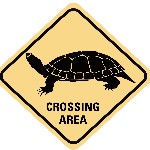
Spring has come! And all sorts of critters are on
the move to find food, establish safe shelters and suitable territories,
and to find places to have their young. This is true for the 10 species
of terrestrial and freshwater aquatic turtles occurring in Massachusetts.
Sadly, many individuals are harmed or killed every year while crossing roads
in search of feeding or nesting areas.
The Turtle Rescue League is a non-profit organization with a mission to
protect New England’s turtles through “education, conservation,
rehabilitation, and incubation programs”. The group’s website
(www.turtlerescueleague.com)
will help you identify the turtle species in your area. It will also tell
you the best action to take if you find a turtle in your yard or in the
road, or if you find an injured turtle.
If your family wants to get more involved with turtle conservation, the
Turtle Rescue League’s website includes instructions on how you can
construct, or donate materials for, turtle-crossing signs. The sign program
aims to prevent the death of endangered turtles from car accidents as
well as prevent injury to drivers of cars and motorcycles who might otherwise
hit a turtle in the road.
top
|
|
QUESTION OF THE MONTH
|

Tell us about an exciting or unexpected
wildlife sighting you’ve had somewhere within the Blackstone River
watershed.
We want to hear from you! Email us at
info@thebrwa.org with
“Question of the Month” in the subject header. Check back next month
to see readers’ responses.
|
Readers’ response to last month’s question:
What is your favorite place to go fishing within the Blackstone River watershed?
- “…any of the cold water streams that hold wild brook trout.
If you can find a stream that isn't stocked with hatchery trout, you're
apt to have some good fishing.”
- “Ponds and lakes with public access for fishing include Hopedale
Pond, Wallum Pond (Douglas), Manchaug Pond (Sutton), Pratt Pond (Upton)
and Lake Singletary (Millbury).”
- “The Mill River, Mumford River, and West River are stocked with
trout so they are basically “put and take.”
|
|
top
|
|
BE GREEN
|
 If you have pets, this is the time of year when you need to start the
battle against ticks and fleas. Many products on the market contain
toxic ingredients. Consider supplementing your pet’s food with
brewer’s yeast or garlic to leave a bad taste in the pest’s mouth.
Pyrethrin from chrysanthemums is a natural alternative to synthetic
pesticides. More ideas can be found at EarthShare’s website
www.earthshare.org.
If you have pets, this is the time of year when you need to start the
battle against ticks and fleas. Many products on the market contain
toxic ingredients. Consider supplementing your pet’s food with
brewer’s yeast or garlic to leave a bad taste in the pest’s mouth.
Pyrethrin from chrysanthemums is a natural alternative to synthetic
pesticides. More ideas can be found at EarthShare’s website
www.earthshare.org.
top
|
|
REFLECTIONS
|
Sculptures, like other forms of art, can be experienced differently by
each person. This is especially true of the 50-foot River Sculpture (1999)
created by Alison Sky for the town of Boise City, Idaho. Installed on
the side of a hotel, it is lit up in neon color at night and can also
interact with water vapor that is released from underground canals.
top
|
Views & opinions expressed in linked websites do not necessarily
state or reflect those of the BRWA.
|
|
Your input is crucial to this eNewsletter. If you have a local
watershed-related story, information of interest to our subscribers, or
comments about this publication, drop an email to the editor.
The Blackstone River Watershed Association (BRWA) has a mission to
engage, educate and advocate for improved water quality in the Blackstone
River Watershed; its objectives are to:
- Engage the public in watershed stewardship activities,
- Educate members, supporters and watershed residents on watershed protection strategies, and
- Improve the water quality and esthetics of the Blackstone River Watershed’s water bodies.
The BRWA eNewsletter is published monthly by the Blackstone River Watershed
Association. BRWA is a 501(c)(3) non-profit organization.
Editor: Susan Thomas susan.thomas@thebrwa.org
Mailing address: BRWA, 271 Oak Street Uxbridge, MA 01569
Phone: 508-278-5200 Web: www.thebrwa.org
Click here for back issues.
|
|




 Team Leaders will work with volunteers at sites in Grafton,
Millbury, Northbridge, Uxbridge, and Blackstone. Please let us know
if you are aware of a site that needs cleaning in these or other towns.
This project meets community service requirements for many organizations.
Every year we have over 100 volunteers including students, scouts,
church groups, business leaders, sport clubs and more. At 3:00p.m,
free pizza and drinks will be provided to cleanup volunteers at the
River Bend Farm Visitor Center, Oak Street, Uxbridge.
Team Leaders will work with volunteers at sites in Grafton,
Millbury, Northbridge, Uxbridge, and Blackstone. Please let us know
if you are aware of a site that needs cleaning in these or other towns.
This project meets community service requirements for many organizations.
Every year we have over 100 volunteers including students, scouts,
church groups, business leaders, sport clubs and more. At 3:00p.m,
free pizza and drinks will be provided to cleanup volunteers at the
River Bend Farm Visitor Center, Oak Street, Uxbridge.



